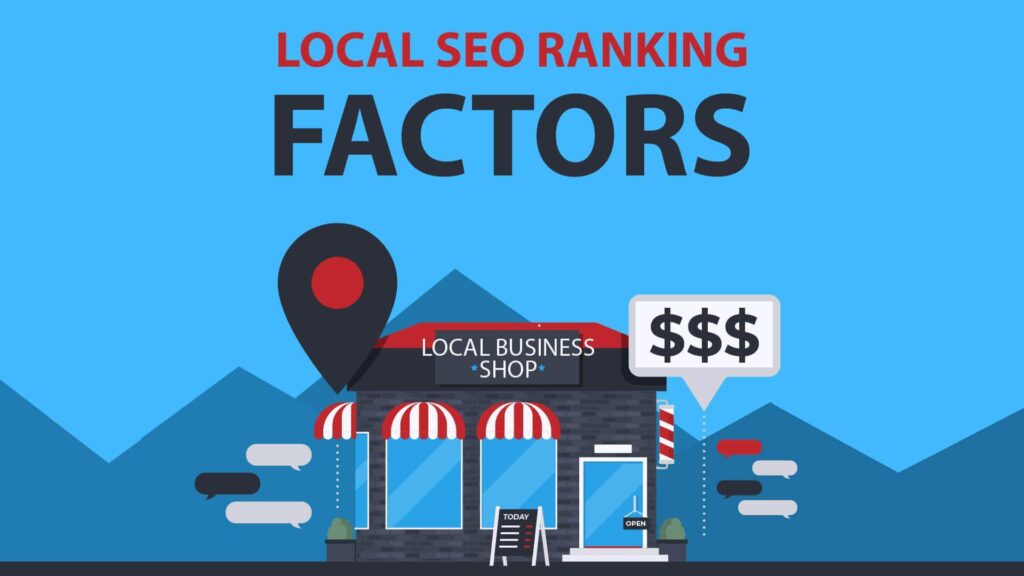Table of Contents
With an uptick in the number of mobile users, optimizing businesses for local search has become a pressing priority. That being said, local business owners are in dire need to direct their local businesses toward growth. Growth in SEO synonymizes enhanced online visibility, higher SERP rankings, and increased traffic and conversions.
While SEO is a pretty handy concept, the same isn’t as easy to put into action. It takes a lot of effort, time, and homework to get things done right. Despite local search ranking signals being one of the most effective marketing methodologies, not many businesses are versed in it. The local businesses have little idea of what local search results are. Their marketing strategy cares even less about the local search ranking factors.
If you are seeking local marketing methodologies to boost your local business growth, you are at the right place. Increase your chances of securing a place in Google’s Local Pack and top organic results via the top local search ranking signals you need to know.
As a local business owner or a digital marketer did you ever wonder, what it takes to appear at the top of local search results?
Or, what could be done to improve your rankings on the competitive local results?
How do I secure a place in Google’s local map pack?
If yes, you would, most certainly, have come across the local search ranking factors. Local search engine optimization, better known as Local SEO is, indeed, the right answer. It can potentially help you in improvising your business for local search results.
Here’s an easy-to-use complete guide on top local search ranking signals you need to know. The following Digital Danish post highlights all the nitty-gritty of local search ranking factors. The later sections of the blog discuss the top local search ranking factors in detail.
What are Local Search Ranking Factors?
If you are an online local business owner selling location-specific products and services, local SEO is your thing. You have to invest time in optimizing the local search ranking of your website. There’s no other way around it. Local SEO will not only optimize your online presence but also help you secure a significant rank on the local SERP for relevant queries.
So, let’s get started.

How about we start from scratch?
I mean, shall we start with understanding what local search ranking factors mean before discussing them in detail?
In the simplest terms, the local search ranking factors can be thought of as the categories or elements that the search engine takes into consideration while determining the positions of a website/business in the local search result. Local search ranking factors can be the characteristics of your website, URL, or on-page elements. There’s a wide range. There are over hundreds of ranking factors that influence your rank on the local search result page. So, it is crucial to understand and work on things that matter.
You have to work and let Google know why you are better than your competitors. You need to convince the search engine algorithm that you are what users need and it shall reward your business with higher organic rankings and include the same in Google’s local pack for relevant queries.
We shall discuss Google’s local pack and how it differs from the organic search results shortly. For the time being, let’s focus on the challenges that you might come across while dealing with local SEO.
Why do Local Search Ranking Factors Matter?
SEO, otherwise known as search engine optimization, is an effective and proven marketing methodology to enhance online presence and visibility. It has a huge impact on an online business. While there is no guaranteed optimization recipe to rank high on the search result page, ranking factors are pretty helpful.
Google’s search algorithm depends on certain search ranking factors to determine websites and businesses offering high-quality content and user experience. Google measures how users respond to and interact with a certain website while assigning it a particular rank on the result page.
The online business/website owners are often recommended to use these search ranking factors to trigger growth. Because we are talking about the top local search ranking factors, the said blog enlists only the ranking factors for localized search results and local map pack.
Challenges in Local Search Ranking
Optimizing a local business to rank high can be challenging in a lot of ways. I have tried to summarize all the commonly faced challenges in five points.

Here’s what they are:
- Mobile Searches – there has been an uprise in the number of searches via mobile phones. Users are using mobile to look for relevant businesses nearby. And not a lot of local businesses/websites are device friendly. That’s one thing
- Rising Competition – Local SEO may have been a not-so-common marketing technique a couple of years ago, but things have changed for the good. There has been a surge in the number of businesses that acknowledge the potential of Local SEO and the local search ranking factors. The value of local SEO is not unknown anymore. So, the competition is pretty tough.
- Google Local Pack – Google Local Pack might be a new term to you. But it outranks all others. This local search ranking factor that once included the top 7 results now shows only the top 3. Again, the competition gets pretty serious.
- Tech Savvy-ness – Starting an online business isn’t as easy. But nothing compares to the struggles of handling the technical nitty-gritty. One can hire a website developer to design the website and get things sorted. But things do not end here. The road ahead is even tougher. You have to manage the marketing strategies. And local SEO isn’t easy at all unless you are an SEO expert or hire one!
- Lack of Knowledge – A lot of businesses do SEO on their own to save some budget but little do they know that the lack of knowledge on their part can cause them bigger losses in terms of reduced SERP rankings.
Now the question in light is, what does it take to appear at the top of serious competitive results and get noticed by Google?
Also, how to get noticed by people that are looking for services like yours?
Well, that’s exactly what we shall learn in the blog. Here I have described 15 top local search ranking factors that could help you. These factors shall help you perform well in the relevant local searches.
Google Map Pack
Earlier you read about a not-so-familiar ranking factor, Google Map Pack. In local search engine optimization, Google pack is popularly known as Google Local Pack. With different names for different search results, the key concept of the Google map pack remains unchanged. That being said, we shall take some time to understand this concept.
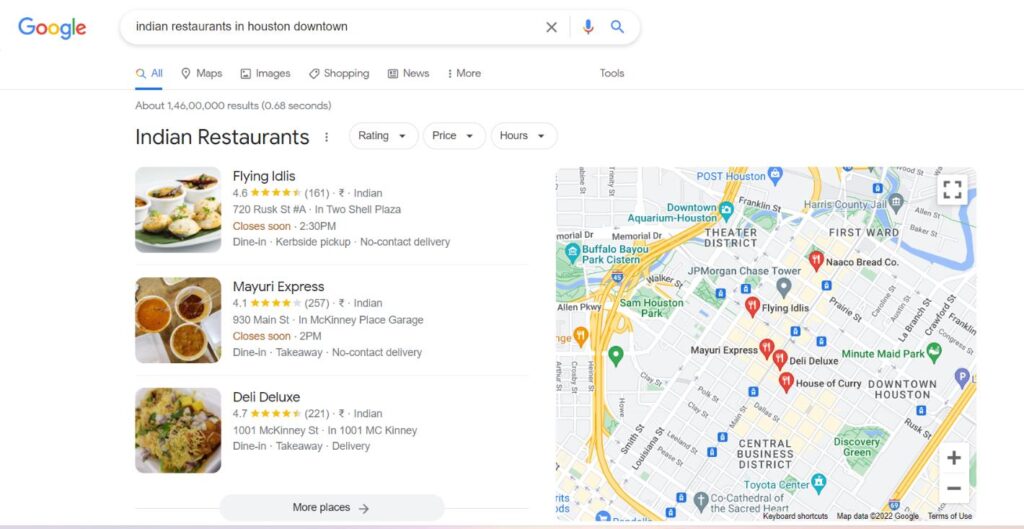
Did you ever notice a search engine result page as such?
The one with prominent results occupies the top section of the result page while the organic results (the one with blue hyperlinks) are at the bottom of the SERP. The Google map pack not only lists the top three businesses for the relevant search query but also indicates their location on the map via the place marker icons.
The Google map pack is, indeed, a very prominent position on the search engine result page. Businesses getting listed in the map pack are often prioritized by the users. A user does not have to click on the URL of the website to seek the needed information. The Google map pack offers information like address, working hours, and common services of a business in the pack itself.
Optimizing businesses for the map pack is crucial, especially, if your business operates locally. In the common man’s language, the Google map pack is a set of top three map-based search results for a relevant local search/query. The map pack includes a summary of the business, its reviews, and ratings, address, featured pictures, working hours, and the location on the map.
The map pack appears above the organic search results. While the organic search results list all the relevant businesses matching the search query, the map pack includes only the top three. As a result, the competition to get listed in the Google map pack is way too fierce.
Recent Map Pack Changes in Google
The map pack being a new normal, there are certain things that you need to know. To be precise, we will be discussing the recent changes.
You have already read about the map pack showing the top three results on the SERP. The purpose was to provide nothing besides useful information to the users. Google constantly works to enhance its services. It has been modifying the local map pack with the same intentions.
The global search engine recently announced rolling out a map pack interface for the desktops. Yes, until now the Google map packs were a mobile-based service, but not anymore. Now a user can resort to the desktop to access the local map pack for any local search. On the desktop, the local results would appear on the left side while the map would occupy the right side of the screen.
Here’s how the Google map pack on the desktop appears.
Why is the Local Map Pack Important?
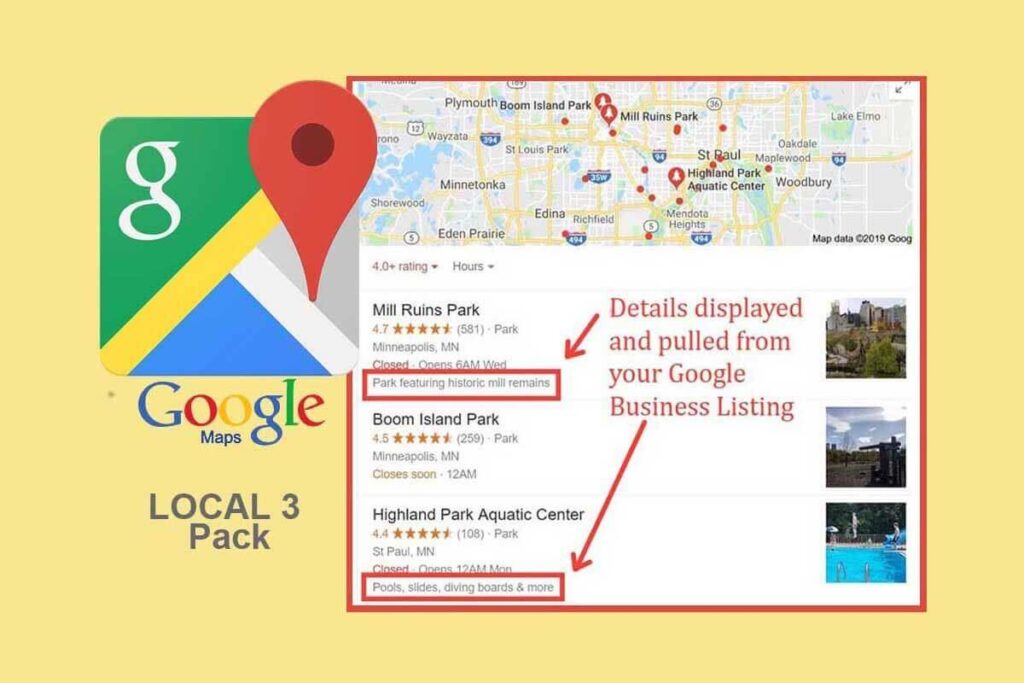
Google’s local map pack offers the local users the convenience to find all the relevant information about a business on the SERP without having to visit the website. A searcher/user can find information like –
- Operating hours
- Phone numbers
- Address
- Reviews
- Summary
- Featured pictures and more quickly
Google’s local map pack makes optimizing a local business for online presence even more crucial. If you hope to increase your chances of appearing in the map pack, local SEO is important. And while it sounds unpleasant, there is no specific recipe to rank #1. However, a couple of ranking factors can assist you in enhancing your online presence efficiently.
The local search ranking factors that can aid you are discussed in the later sections of the blog.
Local Pack vs Localized Organic Results
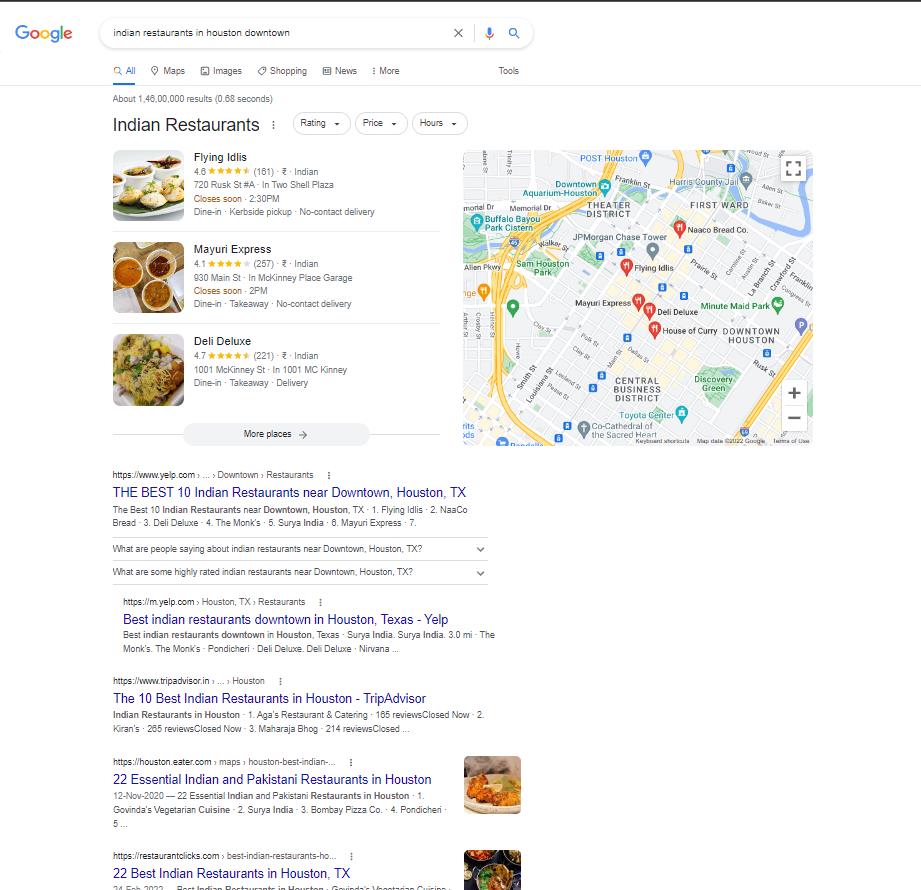
Map packs are a new normal in the search engine result pages. But the traditional blue-links organic result pages are just as efficient. Unless a user is looking for a location-based service, the SERP will only present the organic local result pages. So, it makes sense to understand the difference between Google’s local pack and the localized organic results.
So, here we are.
The Google map pack is a map-based search engine result page. It lists businesses relevant to the search query by showing their Google Business Profiles. The localized organic search results on the other hand consist of the traditional search engine result pages. It indexes the relevant websites with their hyperlinks. The blue hyperlinks direct the users from the SERP to the websites.
Take a look at the said picture to understand the difference.
How to Appear in the Local Map Pack Results
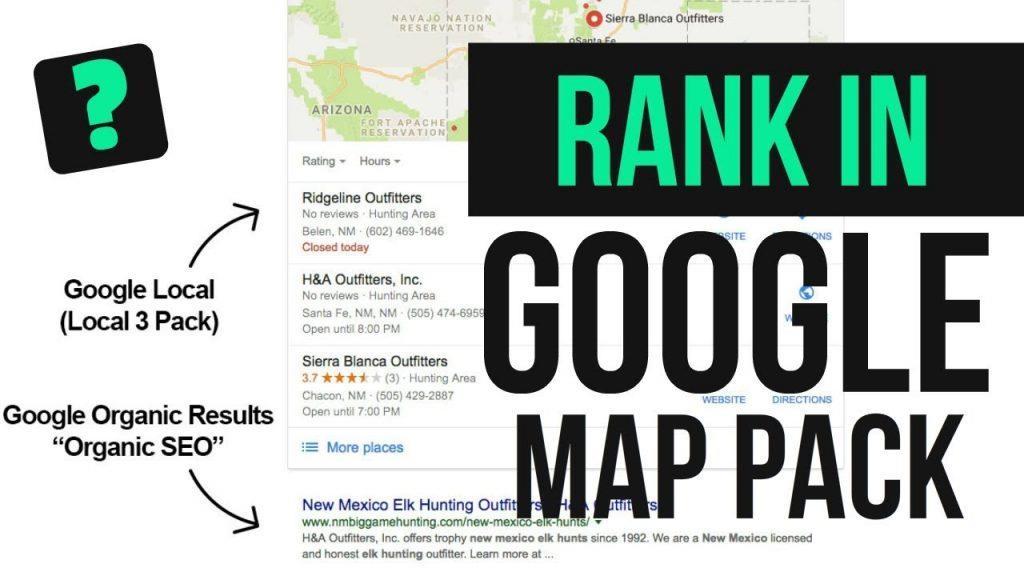
Just as you read above, there is no exact formula to rank high in the localized search results or appear in the map pack at will. It is about getting noticed by Google’s algorithm and convincing it that you provide the services the user needs.
While Google is quite tight-lipped on how the businesses are ranked, the webmasters have some idea. They suggest you can resort to the local search ranking factors and take a dive into the SEO marketing campaigns. There are several steps that the local businesses can follow and increase their chances of being featured in the map pack. Start with the following steps –
- Claim your Google Business Profile
- Generate online reviews, respond to the reviews
- And build citations
Top Local Search Ranking Factors 2022
As I already said, there are more than a hundred local search ranking factors. While each of these factors serves a unique purpose and benefit, covering them all at once is not easy. It is best recommended to depend on the top most important ones at the beginning. Once you start to witness the desired results, you can gradually work on the lesser important ones.
For easier understanding, I have segregated my list of top local search ranking signals into two categories. Them being –
1. Basics Local Search Ranking Signals
As the name suggests, this category enlists only the most basic, fundamental ranking factors. These signals can be thought of as the initial steps towards the success of local SEO.
If you are careful enough to do things as they should be done, getting a grab of these low-hanging fruits should not be tough.
2. Advanced Local Search Ranking Signals
The second category of the local search ranking factors is a bit more technical hence, advanced. It consists of highly technical SEO formulas like data markup or meta description. You might want to hire professional help to utilize the benefits of advanced local search ranking signals.
The Basic Local Search Ranking Factors

The basic search ranking factors are like the low-hanging fruits that you can reach out to and enjoy without much effort. These search ranking factors prominently involve business profile listings, reviews, citations, and accurate business information.
In comparison to the complicated technical ranking factors, this one is pretty easy. You do not need to be tech-savvy to work on these factors. The basic knowledge of SEO would do good. The good part with the basic local search ranking factors is that you do not need professional assistance. Let’s discuss these top local search ranking factors in detail.
1. Business Profile Listings
The most common example of business profile listings is Google Business Profile. Google Business Profile was earlier known as Google My Business.

Google Business Profile and other business listings are super easy and free to claim. The business profile listings are like an online business directory that lists all the important details about your business including name, address, phone numbers, hours of operation, pictures, etc.
Listing your local business on a business profile is an easy and effective way to improve your local search optimization.
- Google Business Profile
Before you start to expect a boost in the number of customers pouring in, ensure that your business profile is set up and verified. Here’s a quick guide set up a google business profile –
- Go to Business Profile Manager.
- Sign in to your Google account/sign up via your business email domain.
- Enter your business name and click next.
- Select your business from the suggested businesses listed. If your business is pre-verified by someone else, put up a request to claim the ownership of the same.
- Search for and select the business category that matches your business.
- Click next and choose the location of the business. Enter the business address manually or position the place marker icon on the map.
- Click next. Enter the service area of your business.
P.S.: The service area should not be more than 2 hours of driving time.
- Enter the contact details like phone number, email, and website URL. Click Next followed by the Finish button.
- The last step is to verify your Google Business Profile.
- GMB Profile Categories
The categories in the business profile describe your business. It notifies the search engine and the users about what you do. It helps you connect with the customers who are looking for you. I suggest you be specific and choose a business category that describes your business the best.
For instance, if you run a sports café, selecting the Café as your category would not be enough. Being specific and selecting a Sports café will direct relevant traffic to your business.
- Photos
You should add featured photos and videos of your business on your Google Business Profile Page. The photos can showcase anything from your store to staff, in-store products, and services, location, or the customers. Do not upload the photos of your customers without their permission, though.
The featured photos and videos represent your business as interesting. They add credibility to your business besides serving as a proven local search ranking factor.
- Bing Places For Business
Google is a global leader of search engines but Bing and other less prominent search engines still hold a big fraction of your target customers. Bing alone accounts for 7% of the total searches. So, be mindful to consider other top search engines.
Safe your ground by setting up a business profile on Bing Places for Business.
2. Online Directories and Citations
Today, online directories are no different from what the world knew as popular Yellow Pages a couple of years ago. Online citations are a great help in getting accurate and consistent information about a business on the search engines. The citations also help in generating quality backlinks from authoritative websites.
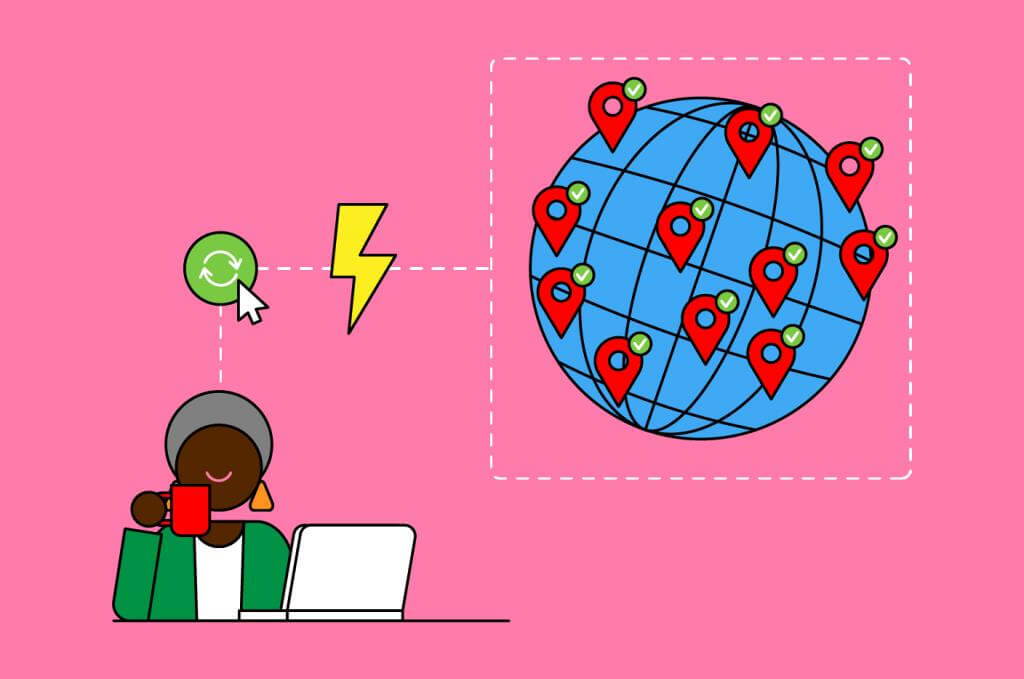
The users often resort to online directories and citations to seek products and services they need. Also, dig information like contact details about the stores that provide what they need.
Even the search engines rely on the online citation directories to analyze a business’s authority in the niche market and area. Business information consistency across citation listings is a crucial local search ranking factor. Claiming your local business on online directories reaffirms your accurate contact details.
So, make sure to claim your business on all prominent online directories including –
- Apple Maps
- Yahoo’s Localworks
- Foursquare
- And the Yellow Pages App is a must.
3. Listings on Review Sites
- Positive Reviews
Whatever the scenario, the customers will always prioritize reading online reviews about your business before coming in. Also, the search engine algorithm considers reviews as a crucial local search ranking factor.

Positive reviews about your business not only influence a customer’s decision-making in your favor but also optimize your online presence. Businesses that receive frequent positive reviews are often painted as reliable. They receive higher rankings on the local search results.
When I say reviews are one of the important local search ranking factors, I am not talking about the number of reviews only. What I mean is, that the ranking signals consider the following elements of the reviews –
- Total number of reviews
- Frequency
- Diversity
- Quality (positive/negative)
- Reviews responded
Google takes genuine and positive reviews from its customers as a sign of quality service. It thinks that your customers are pleased with what you offer. And because Google’s primary concern is to put the users above everything else, it serves businesses with positive reviews with good SERP rankings.
So, reviews are important. Encouraging your clients and customers to write a review about their experience with your business can be a good approach.
- Keywords and Locations
Not all reviews are alike!
Online reviews can be diverse. And diversity in reviews can be quite beneficial. For instance, if a customer uses relevant keywords or locations in his review, Google and other search engines acknowledge you as a reliable local business.
Or, if he mentions any specific product/service in the review, the google algorithm thinks you are a trusted store. So, if you offer a variety of products and services, encourage your customers to be specific about them while writing their reviews.
- Responses
As a business owner, your response to the reviews matter. A lot at that. Your response to the reviews and concerns penned in them shows that your business is actively managed. It shows that you take time to engage with your customers and address their concerns.
A good local SEO plan involves an effective strategy in place to respond to the reviews, particularly the negative ones.
- Negative Reviews
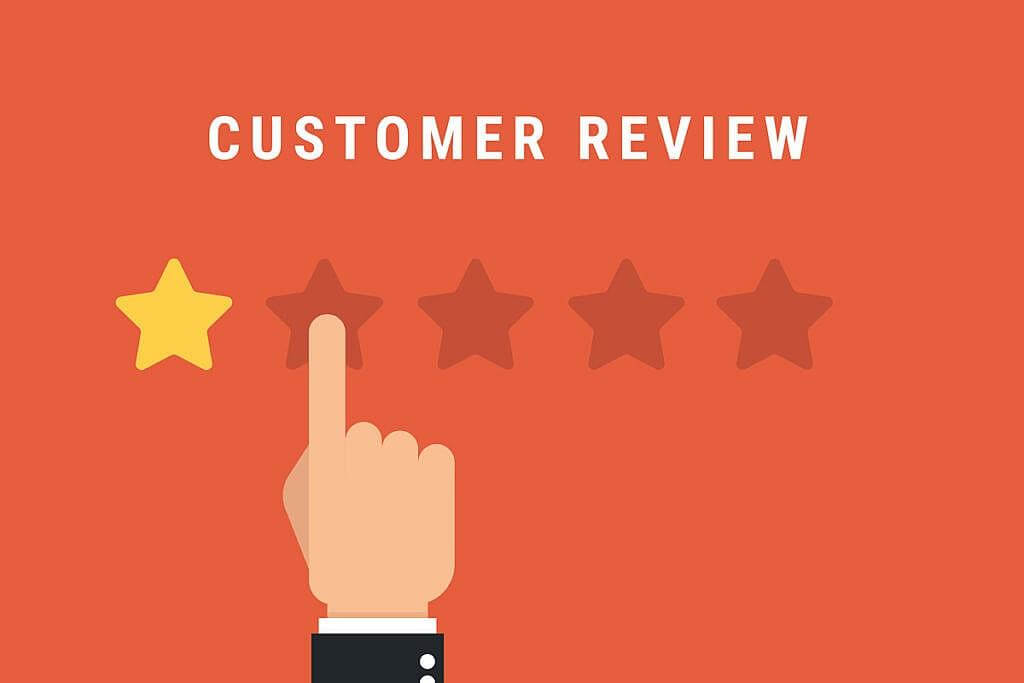
While positive reviews portray your business as trustworthy, legit, and reliable, negative reviews can turn things upside down. Be mindful to address the reviews about your business, especially the negative ones. Address the concern of your customer as soon as possible. And once the issue is resolved, encourage your customer to change his review.
If you find any review to be inappropriate about your business on Google, you can get it removed.
4. Business Page

A big fraction of online users is quite comfortable with using social media, particularly Facebook and Instagram. It uses the social media platform as a search engine to seek products and services it needs. And having a business page on Facebook and Instagram can come as handy.
So, that has to be on your to-do list.
Create a business page on all the prominent social media platforms including Facebook and Instagram. Update the same with your website, operating hours, description, address, etc. If possible, update your business page regularly. You can share information about your in-store products and services, special events, holidays, new arrivals, and more.
5. Social Listings
Social signals may have a limited impact but it is still pretty efficient in outreaching potential customers.
Irrespective of whether you plan to have an active social media page or not, you should at the very least claim your business on all the social media sites.

Pin a post on your website and invite users to follow you on all the social media sites that you are upon. Then again encourage your followers on social media to visit your website. Customers often reach out to you on social media with their queries. Fast responses by the businesses are recommended.
6. NAP(E)
NAP (E), popularly known as NAP stands for Name, Address, Phone Number, and Email.
Being consistent and accurate about your business information is important. Your NAP details across all mediums should be consistent. It helps Google provide accurate information every time a user searches for you or the products/services you offer.

Consistent NAP makes it easier for customers to connect with you. Even a slight difference in the information on the two media can cause a lot of confusion. For Instance, your business name on a certain online directory is $AM’s Mart and that on another is SAMs Store.
Google and other search engines can get confused with inconsistent information and that could lead to a loss of website traffic. So, attention to even the smallest details is important.
7. Mobile Responsiveness

When it comes to local searches, the number of searches via mobile outrun the searches done on the desktop. As a result, Google and the other prominent search engines prioritize your mobile website over the desktop version.
Your website should be accessible via mobile phones. Thus, investing time in creating a mobile responsive website/business is the need of the hour.
Highly Technical Local Search Ranking Factors
The local search ranking factors stated so far are some of the top non-technical ranking signals beneficial for local SEO. Coming next are the advanced factors that might require professional help. The reason being they are highly technical and incorporate the structural elements of a website. That being said, let’s dive deeper into our journey of exploring the top local search ranking signals.
8. On-Page Signals/Location
Every time the search engine analyses the local businesses for any search query, it considers several on-page signals.
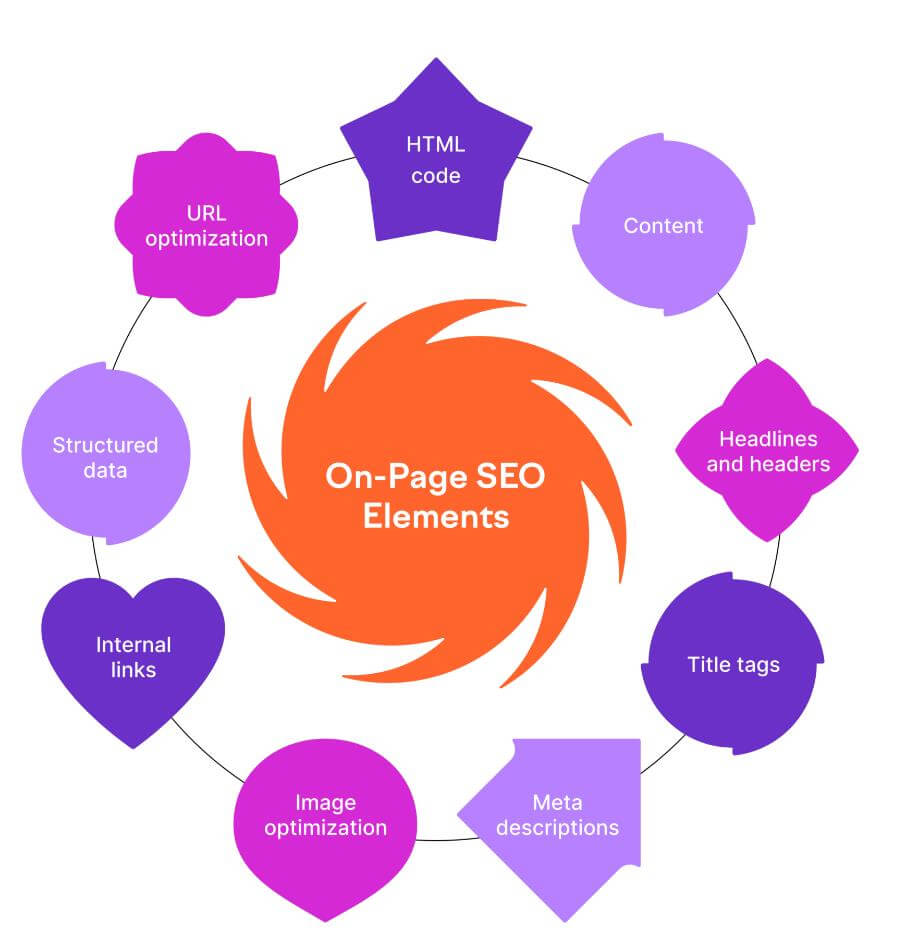
Here are some of the on-page local SEO factors you might want to work on –
- Use of relevant keywords
- Appropriate keyword density
- NAP
- Mobile-friendliness
- Short and descriptive page URL
- Optimized title tags
- Compelling meta descriptions
- Structured data markup
- SEO copywriting
People are always looking for information on search engines. You can make it easier for Google to notice you for relevant searches and return the users with quality results. Remember, if you have an optimized website providing valuable information, products, or services, Google will reward you with good rankings.
9. Structured Data Markup
Structured data, in general, refers to the set of organized and structured data. On a website, it synonymizes organized and structured data that is tagged with group texts. It helps the search engines read and process the context of data. The same shall guide the search engines into returning with accurate and valuable search results for the said search queries.
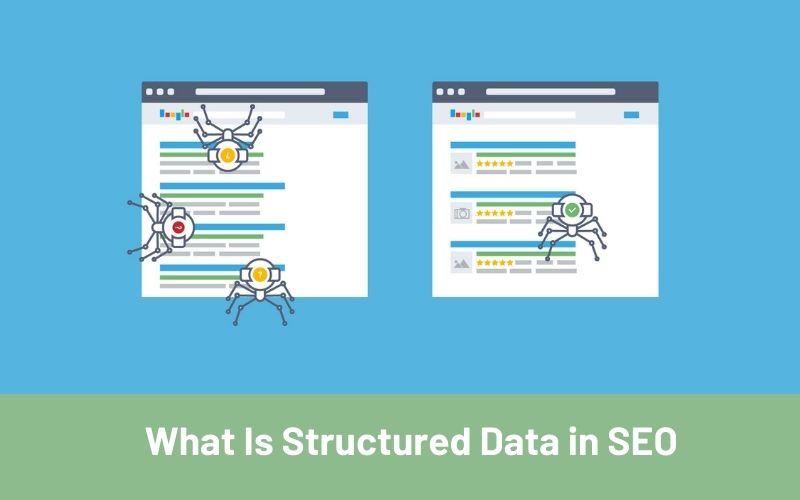
By definition, the structured Data Markup refers to the machine-readable representation of your products/services on the website. Using schema markup (semantic vocabulary) code on your website will assist Google and other search engines in reading, understanding, and processing your content efficiently.
If you have a business that serves customers of a specific region, say you are a local business owner, you shall add your walk-in address and other important details on your website. It shall help the search engines with your primary address. It is best recommended to present this information in a machine-readable format. I would suggest you use the local business schema. Here’s how you can add structured data markup to your website.
- Start with opening the Structured Data Markup Helper of Google.
- The next step is to select your data type.
- Now enter the URL of your website.
- Here, highlight the page elements that you want the search engines to notice and assign data tags.
- The step that follows involves creating HTML.
- Now add schema markup to the webpage and text the markup.
- You can use the Structured Data Testing Tool of Google to test the markup created.
- If any, fix the issues detected during the test.
- Now sit and wait until Google notices and re-crawl the new HTML for relevant search queries.
10. Behavioral Signals
Behavioral signals in search engine optimization refer to how the users perceive your website. It primarily involves the engagement rates and the factors associated. In local SEO, the behavioral signals indicate how the users interact and engage with local business websites and listings.
The search engine algorithm uses several behavioral signals to determine the position of a website/business on the search result pages. Some of the common user behavioral signals monitored by the search engines include –
- Click-Through Rates
- Mobile Click to Call
- And Social Media Check-Ins via the website

Now, let’s discuss what each of these behavioral signals in local SEO means.
- CTR from SERP
CTR, better known as click-through rates from the search engine result page is the number of times the users click through to a website from the search result page.
- Mobile Click to Call
The majority of the local businesses offer call-to-know services on their website. Mobile click to call refers to the dial button on the website that directs the users to the dial keypad with the business’s calling phone number.
- Social Media Check-ins
Social media check-in refers to the scenario where a user is in the business store and uses social media platforms to check-in.
A search engine uses the said behavioral signals to analyze which business is relevant, attracts, and engages most customers. A successful local SEO campaign shall involve a plan to track the behavioral local search ranking signals. It shall also be prepared to make suitable adjustments to attract and engage potential customers.
11. Localized Content
While consistent information about the business across all media is important, do not ignore the regularized publication of content. Because many changes may come but consistent publication shall still be crucial. Ensure using the relevant keywords and your location in the content organically. Set a certain content goal and measure the progress.

It might sound like an ineffective methodology, but publishing content relevant to the local community always helps. Users like to engage with the brands that serve relatable and relevant content. Localized content, in general, involves blogs, articles, news pieces, graphics, videos, podcasts, and community-based events. You can appeal to a big fraction of target customers by using organic and location-based keywords, phrases, etc. The same shall improve your visibility in the local search results.
12. Keyword Optimization
Keyword optimization of a website is quite essential. But it is even more important to do that correctly. For instance, you have a sports café in Westheimer Road, Houston in Texas, USA. Now, you want to use relevant keywords in your content copywriting.

Using keywords like Sports Café in Houston would do good. But if you are being specific and using KWs like Sports Café in Westheimer Road, Houston, it will help a lot. This way search engines would get a clear image of where you are located. And it will direct the customer seeking a sports café near your location to your business.
Then again, while using the right keywords is important, keyword density should be kept in mind. You cannot overload your content with keywords. KW frequency has to be genuine. The keywords should be placed organically and be used only in the places needed.
13. Meta Description + Title Tags

Meta Description and Title Tags Increase CTR Rate
If your SEO campaign is succeeding, you will do good in local SEO without a doubt. Just be mindful of meta-titles and descriptions.
On the exterior, it may seem like meta descriptions and title tags do not qualify as a search ranking factor, but they do. But if you study SERP click-through rates, you shall find why I said what I said. Let me ask you a question.
How do you determine which website on the SERP is the right choice for your query?
I know, your answer would be that you read the meta description. There you go!
Meta description influences the CTR of a website, it has to be done correctly.
Whenever feasible, use the key terms and location-based keywords in the meta description and titles of your website and webpage. Doing so coordinates well with on-page location as well as keyword optimization. Also, make sure that the meta description of your website does not exceed 160 characters. The length of the title tags should be close to 50-70 characters.
14. Backlink Profile
Backlink, as the name suggests, refers to the links coming from other websites. These links direct the users from another website to your website.
Backlinks can be an ideal methodology to build authority in the niche market and search engines. Backlinks from trustworthy websites are good for SEO. That being said, local businesses aim to attract links from relevant and authoritative websites.

But as appealing as it sounds, getting backlinks can be challenging. Also, the quality of backlinks received matters more than the quantity. The backlink profile of a local business plays a significant role in determining how the search engines evaluate your business.
You can initiate your local link building from the following websites –
- Local directories
- Industry publications
- Local blogs and event pages
- Local publications
- Local community websites
The local search ranking factors associated with backlink profile involves –
- Frequency of inbound links `
- Relevancy of the links
- Linking domain authority
- Anchor text used in the links
- Diversity of inbound links
- Keywords used in anchor texts
15. Domain Authority
The domain authority of a website plays a big role in determining its ranking on the search engine result page. For the unversed, domain authority refers to the search engine ranking score of a website. It gives search engines an idea of how successful a website is. Domain authority was created by Moz. It gives an overview of a website’s likely performance on the search engine result page.

The domain authority scores above 60 are regarded as excellent. But if your website scores between 40-50, it means you are performing well. There are several ways to improve the domain authority. Some of the most-effective methods are –
- Acquiring quality backlinks
- Regularized backlink audits to remove bad links
- Structured data
- Internal links
- Quality content
Optimizing your domain authority may not be an easy or quick process, but it is just as effective. It pays off quite well.
Takeaway
There is nothing like a guaranteed SEO strategy. It is all about creating tailor-made SEO strategies that match the requirements of your website. Local SEO optimization can be best defined as a process of research, plans, and implementations.
There are hundreds of local search ranking factors. While some of these factors may deliver quick results, the others can take several months before showing any progress. The key to success in SEO lies in acknowledging where your priorities lie. And once you get there, all you need is a planned strategy.
Work on what you have planned and things will go north for sure.
Take a look at some of the most frequently asked questions about local search ranking factors.
Frequently Asked Question | Local Search Ranking Factors
1. What are the top local search ranking factors that influence local search results?
There are more than a hundred local search ranking factors that influence the local search results. The top 5 ranking factors which can potentially affect the local search results include –
- Google Business Profile
- On-page signals
- Online citations
- Online Reviews
- Link-Building
2. What are the local search ranking factors?
The search ranking factors are the criteria that the search engine algorithm uses to determine the SERP rankings of the websites. The local search ranking factors are more specified ranking factors that affect only the local search ranking. The most commonly known local search ranking factors are –
- Google Business Profile
- On-page Signals
- Data Markup
- High-Quality Content
- Online Citations and Reviews
- Link-Building
- Domain Authority
- Consistent Information, etc.
3. How do I rank high in Google local search?
The one-word answer is local SEO!
Online businesses can improve their local ranking on Google by claiming their Google Business Profile. Claiming GMP is the first step towards local SEO. The entire process starts with using the GBP to claim and update your business information. Doing so will notify the Google algorithm that you are an active business and provide services for the claimed categories.
To optimize your presence in the local search for the said search queries, update your business information.
- Enter complete data
- Verify your locations
- Working hours
- Manage reviews
- Add featured photos
- Add in-store products/services
- NAP(E)
- Enter consistent information
4. How can I improve my local SEO?
Here are some proven ways to boost your local SEO strategy. Bring these tips and tricks into action to enjoy the best results out of your local SEO campaign –
- Claim and optimize GBP listing
- Mobile-friendliness
- Manage and respond to reviews (positive as well as negative reviews)
- Local link building
- NAP
- Online citations
- Social Listing
5. How does Google determine local search rankings?
Google and its algorithm determine the value of a local business on the following three grounds – Relevance, Distance, and Prominence. Thereafter, the web crawler indexes websites according to the local search ranking factors.
- Relevance
Does your local business match the given search query?
Does your business offer what the user is looking for?
- Distance
How far away you are from the user’s location. If your business is relevant and located nearby, you’ll get a good ranking.
- Prominence
The online citations and reviews come into play here. Google analyses your business to see
How popular are you?
What do your competitors say about you?
If you are located far away but offer better products and services, and are more relevant, Google would reward you with better rankings than the closely situated businesses.
6. How do I manage my Google Business Profile?
Unlike local SEO, managing your Google Business Profile is just as easy. Just be careful to provide accurate, complete, and engaging information and you are good to go.
- Enter complete data – physical address, phone number, category, attributes
- Location verification
- Accurate working hours – opening and closing time, operating hours, special hours, weekends, holidays, events, etc.
- Managing & responding to reviews – respond to positive as well as negative reviews.
- Add photos – showcase what you offer, goods, products/services, etc.
- In-store products – retail businesses can add in-store products to their GBP.
- NAP – be consistent in updating NAP (E). It stands for Name of the Business, Address, Phone Number, and email.
